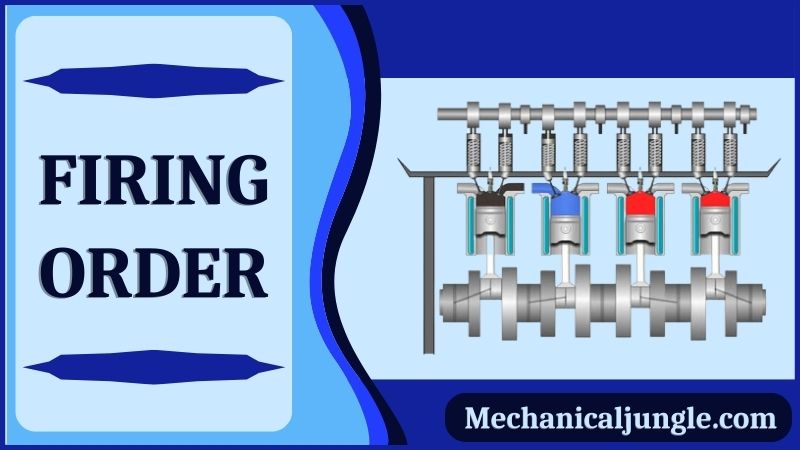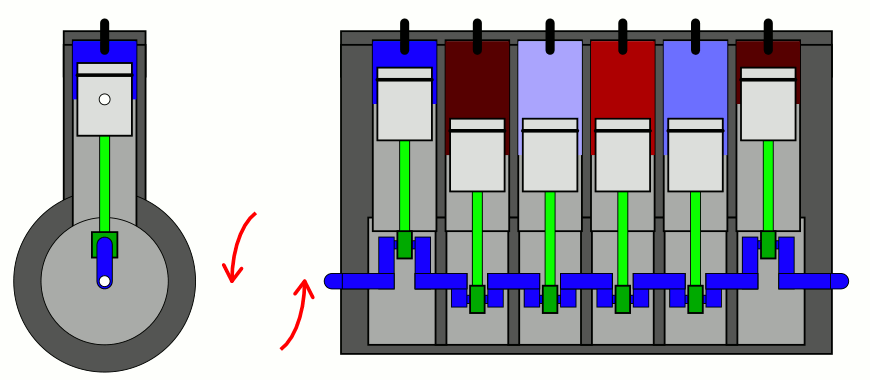Important Point
What Is Firing Order?
The firing sequence of internal combustion engines is the sequence of ignition for the cylinders in spark ignition, eg. For gasoline/petrol engines, the firing order corresponds to the order in which the spark plugs operate.
In diesel engines, the firing order corresponds to the order in which fuels are injected into each cylinder. Four-stroke engines must also time the valve openings relatives to the firing order, as the valves do not open & close on every stroke.
Firing order is the order of power distribution of each cylinder in a multi-cylinder reciprocating engine. This is achieved by placing the spark plugs in the correct sequence in a gasoline engine or by the sequence of fuels injection in types of diesel engines.
When designing engines, it is important to choose an appropriate firing order, to reduce vibration and to have a long engine fatigue life and user comfort, and to heavily influence crankshaft designs. The firing order of engines is the order in which electricity is incident to the different cylinders.
The firing order is designed to provide balance and maximize vibration as much as possible. In a radial engine, the firing order must follow a particular pattern as the firing impulses must follow the motion of the cranks throw during its rotation.
In inline engines, the firing order can vary somewhat, yet most of the order is arranged so that the firing of the cylinders is evenly distributed along with the crankshaft. Firing order affects the vibration, sound, and symmetry of the power output from the engine. Firing order greatly affects crankshaft design.
Why Do We Need Firing Order?
As we all know that the four-stroke engine we are using today works on an autocycle or diesel cycle, which includes suction, compression, power and exhaust, four strokes, or reciprocating.
This is accomplished in four movements of the piston, and when it comes to engines with more than one cylinder, the process becomes quite complex, hence the need for a pre-determined sequence of combustion or firing of the fuel like- When it comes to more than 1-piston the load on the crankshaft increases as all the pistons are connected to a single crankshaft and if proper firing order is not provided to the engine the crankshaft will likely fail.
The proper firing sequence of the engine provides maximum power, smooth running, and high life to the engine and also protects the engine from unwanted vibrations.
Of all the four-stroke suction, compression, power, and exhaust required to complete the engine’s cycle, the power stroke is the strongest and generates both mechanical or thermal stresses that can lead to engine failure; therefore, It is required for a multi-cylinder engine that the power stroke in any two adjacent cylinders must not occur at the same time, which is why the engine must have a pre-determined and proper firing order.
Improper firing order can affect engine and crankshaft balance due to uncontrolled stress generation resulting in harsh running, unwanted sound, and unwanted vibrations from the engine, which can suddenly break any component of the engine and is quite a dangerous operator or people around.
The improper firing order of the engine directly affects the fuel economy of the engine due to improper combustion due to improper firing order. The operator faces problems in starting the engine due to disturbed spark timing due to the improper firing order of the engine.
Need of Firing Order in Multicylinder Engine:
It is desirable that the power impulses be evenly spaced and balanced. If all cylinders are firing simultaneously, the power delivery will be very jerky, so the engine is set up for cylinder firing for smooth power delivery. If the piston moves in a certain rhythm, they must also get their spark in a certain rhythm, so the engine will run smoothly.
The optimum firing sequence of an engine ensures:-
- Low engine vibration
- Better – engine cooling and
- Reduction in backpressure.
Firing Order of Different Multi-Cylinder (2, 4, 6) Engines:
To better understand the firing order of an engine, let us take a few examples of the various multi-cylinder engines used in today’s automobiles.
#1. Tata Nano’s inline 2 Cylinder Engine
In the Tata Nano, a 2-cylinder inline engine is used even though it is more than a 1-cylinder engine; the firing order is not so complicated as it is quite clear when firing will take place in cylinder 1 or as compared to cylinder 2. Spark plug ignition will occur on the compression stroke, and the firing sequence will be 1-2.
#2. In-line 4 Cylinder Engine of Maruti Suzuki Swift
Cars such as the Swift have 4 cylinders mounted in a straight line, with the firing order configured as 1-3-4-2, meaning all cylinders will fire or 1-3-4- According to 2, there will be spark plug ignition.
Sequences, it is found that in a 4-cylinder engine, a complete firing order gives 720 degrees of crankshaft rotation, which means that each power stroke by the individual pistons gives 180 degrees of rotation to the crankshaft.
In an inline 4-cylinder engine, all 4 cylinders are mounted on four pins of the crankshaft placed every 180 degrees to the crankshaft. For the smooth operation of a 4-cylinder engine, it is necessary that each cylinder will have a different stroke at any point in time. For example-
Any time in an inline 4-cylinder engine, it is usually seen that when cylinder 1 has the power stroke, cylinder 4 is usually seen as the suction stroke, and cylinder 2 and cylinder 3 usually have exhaust and compression. It is seen in Strokes respectively.
#3. V-shape 2 Cylinder Engine of Harley Davidson Iron 833 Bike
The Harley Davidson Iron 833 uses a V-shaped 2-cylinder engine with the same firing order of 1-2 as the inline 2-cylinder engine mentioned above.
#4. V-shape 6 Cylinder Engine of Honda Accord
In the line of high-end cars, the Honda Accord and Audi A-8, high-powered engines with multiple cylinders are used; in the Honda Accord, a 6-cylinder engine placed in a V-shape is used for proper and effective firing.
Order is required. The firing order in the Honda Accord 6-cylinders placed in a V-shape such that 1,2,3 cylinders are placed on the left and 4,5,6, are placed on the right is configured as 1-5 is -3-6-2-4, the firing order 1-5-3-6-2-4 means that the piston mounted crankpins are arranged every 60 degrees of the crankshaft.
Since a power impulse is generated every 720-degree rotation of the crankshaft, this means that the power stroke in a V6 engine is received in every 120-degree rotation of the crankshaft.
#5. The Flat-Six Cylinder Engine Used in the Porsche 911 GT3
In some cars likes Porsche 911, GT3 6- cylinders are placed in the opposite direction in the horizontal plane, i.e., and cylinders 1,2,3 are placed on the left, and cylinders 4,5,6 are arranged on the right, use is done. As in the V6 engine, all pistons are mounted on 6 crankpins placed every 60 degrees of the crankshaft.
The firing order of these types of engines is configured as 1-4-5-2-3-6, meaning that firing or spark ignition will occur every 120 degrees of crankshaft rotation.
The firings order of 2, 3, 4, and 6 cylinders in tabular form are given below:
| S.no | Number of cylinders | Firings Order |
| 1 | 2 | 1-2 |
|
2 |
3 |
1-2-3, |
| 1-3-2 | ||
|
3 |
4 |
1-3-4-2 |
| 1-2-4-3 | ||
| 1-3-2-4 | ||
| 1-4-3-2 | ||
|
4 |
6 |
1-5-3-6-2-4 |
| 1-4-3-6-2-5 | ||
| 1-6-5-4-3-2 | ||
| 1-2-3-4-5-6 | ||
| 1-4-2-5-3-6 | ||
| 1-4-5-2-3-6 | ||
| 1-6-3-2-5-4 | ||
| 1-6-2-4-3-5 | ||
| 1-6-2-5-3-4 | ||
| 1-4-2-6-3-5 |
Frequently Asked Questions (FAQ)
What Is Firing Order?
The firing order of an internal combustion engine is the sequence of ignition for the cylinders. For this inline-4 engine, 1-3-4-2 could be a valid firing order.
Firing Order
The firing order is the sequence of power delivery of each cylinder in a multi-cylinder reciprocating engine. This is achieved by sparking the spark plugs in a gasoline engine in the correct order or by the sequence of fuel injection in a diesel engine.
Need of Firing Order in Multi Cylinder Engine
It is desirable that the power impulses be evenly spaced and balanced. If all cylinders are firing simultaneously, the power delivery will be very jerky, so the engine is set up for cylinder firing for smooth power delivery.
Why Do We Need Firing Order?
The firing order in an engine is important because a correct firing order can cause minimum vibrations in the system. Minimum vibration in automobiles is desired as the ride can become smooth, and the driver and passengers won’t feel the vibrations being transmitted by the engine as it is very less.
Like this post? Share it with your friends!
Suggested Read –
- Difference Between Orthogonal and Oblique Cutting | Orthogonal Machining
- What Is Magneto Ignition System | How Does an Ignition System Work | How Does a Magneto Work | What Does a Magneto Do | Magneto Ignition System
- What Is a Synchromesh Gearbox? | Principle of Synchromesh Gearbox | Construction of Synchromesh Gearbox | Working of Synchromesh Gearbox
- Working of Constant Mesh Gearbox | What Is a Constant Mesh Gearbox? | Different Gear Ratios in Constant Mesh Gearbox | Construction of Constant Mesh Gearbox
- What Is Cupola Furnace? | Cupola Furnace Design । Cupola Construction | Purpose of Cupola | Working Principle of Cupola Furnace: | Advantages of Cupola Furnace | Disadvantages of Cupola Furnace | Applications of Cupola Furnace

